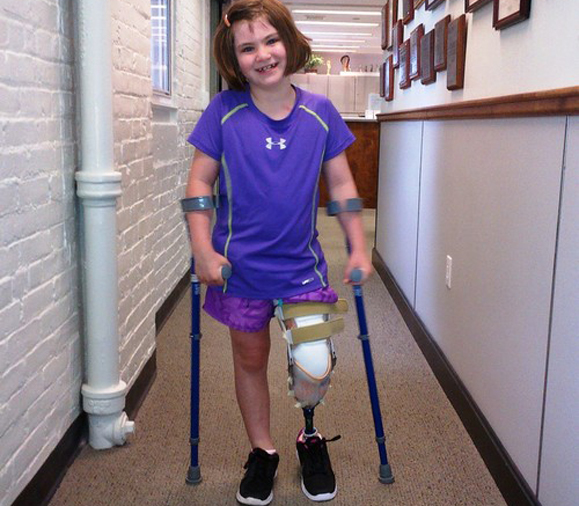Jane Richard is dancing again.
Jane Richard, the tiny Irish step dancer from Dorchester, who lost her left leg in the Boston Marathon bombing in April, endured 12 operations on her leg last Spring, followed by months of physical therapy at the Spaulding Rehabilitation Hospital. Jane’s nine year old brother Martin was killed by the bomb, and both her parents suffered injuries.
Like many of the survivors and victims of the bombing and its aftermath, the Richard family has been out of the public eye for months, focused on recovery and putting their lives back together, but buoyed by the outpouring of love and support from their neighbors and from strangers around the world.
In August, the Richard family issued a statement expressing the pure agony at the loss of Martin, while cherishing the small victories they find:
“Jane continues to be an incredible source of inspiration – and exhaustion. The loss of her leg has not slowed her one bit, or deterred her in any way. As we knew she would, when we finally returned home, Jane walked into the house with the aid of her crutches, but under her own power. She has since received her prosthetic leg. And while she is getting more comfortable with it, she is also limited with how much she can wear it at any one time. When she is able to have it on, she struts around on it with great pride and a total sense of accomplishment. Her strength, balance and comfort with the leg improve every day. Watching her dance with her new leg, with her weight primarily on the other leg, is absolutely priceless.”
Meanwhile, Boston continues to rebound after the bombing, seeking to return to a normal pace of life that belies the hurt inflicted by a reckless, ill-conceived act of ignorant brutality. Boylston Street in the Back Bay, the site of the finish line, is bustling once again with students, tourists, conventioneers and office workers. The metal barriers that enclosed the crime scene for several blocks are gone, and the small businesses that shut down have re-opened.
The sprawling public memorial at Copley Square, which sprouted up in the aftermath of the bombing, was carefully dismantled in June by city officials, and the artifacts will become a permanent part of the city’s archival history.
Dr. John McColgan, Boston’s chief archivist, oversaw the deconstruction of the public memorial. A day after the bombing, he explained, a make-shift memorial had appeared at the corner of Boylston and Dartmouth: assorted sneakers, race badges, and shiny silver foil blankets that marathon runners use to cool down, along with flowers and notes of condolence. When those streets opened up to traffic, officials moved the materials over to Copley Square, one of the city’s beautiful public spaces, and just yards away from the finish line.
The Copley Square memorial grew daily, as residents and visitors made a pilgrimage to the site, to reflect quietly on the tragedy, to make a gesture of solidarity with the victims, to find comfort in shared grief. When the rains came, McColgan and his crew moved paper materials like cards and placards inside to protect them, and later they took away dozens of teddy bears and stuffed animals, but new materials appeared and the memorial continued to grow.
“The city was sensitive to the victims,” McColgan said. “We conferred with them about the best time to take the materials down. We had an initial meeting with the families at the end of May, but some of them weren’t even ready to go down to visit the park.”
On June 26, the city held a private reception for the families of the victims and the injured, and about 200 people attended. The following morning, at 6:00 a.m., the preservation team began dismantling the memorial.
“I was taken aback by the volume of materials,” says McColgan. “Thousands of people wrote on banners – completely covered, with notes, individual notes and placards. Someone went to the trouble of cutting up thousands of pieces of blue and yellow strips of paper to create a paper chain for people to write on. The people of Newtown, Connecticut sent a card, and thousands of notes were addressed to the Richard family.”
The four people killed – Martin Richard, Krystle Campbell, Lu Lingzi and Sean Collier – have not been forgotten, nor have the hundreds of victims who suffered life-changing injuries due to the blast. The OneFund, set up to assist the victims of the bombings and their families, has raised over $69 million in donations from 185,000 people in all fifty states and in fifty countries around the world, from individuals and businesses, from lemonade stands and neighborhood fundraisers.
Dick Donohue, the transit policeman injured in a shoot-out with the bombers, is on the road to recovery, and has been appearing at Red Cross blood drives and other charitable events for the victims. Donohue, who went into cardiac arrest from loss of blood from his gun shot wound, was saved by first responders and medical staff at Mt. Auburn Hospital in Cambridge.
In 2014, the Boston Marathon will return stronger than ever. Boston Athletic Association officials announced they will add 9,000 extra runners, for a total of 36,000 runners competing next year. The 5,624 runners who did not finish this year’s race after it was halted by the bombings are being invited to run the race in 2014.
And Jane Richard is dancing again.
For information on OneFund, see: onefundboston.org
For the Richard family, see: richardfamilyboston.tumblr.com
Boston Marathon: The Road to Recovery
By Michael Quinlin, Contributor
by Leave a Comment
by Leave a Comment


Leave a Reply